Back Strain Muscle Pain & Treatment Options
Areas of chronic back strain develop certain patterns of pain. This can assist with pain relief by using methods to address the areas of muscle strain directly and by modifying some behaviors.
Direct pressure to the areas of strain can be used with one or two fingers to apply a steady tolerable pressure for a minute or two. Then use similar pressure while performing a circular movement with your fingers for another minute or two. Typically, the location of these areas on the back are difficult to reach. You may use a tennis ball while lying on the floor or with your back against a chair, have someone do it for you, or try using devices that are designed specifically for the treatment of these areas.
Click on pictures to enlarge for better view.
In the following examples, the “X” is the area of strain and the focus of where to apply pressure, while the red dots are areas of discomfort associated with the points and help to identify the areas. Click on the pictures to enlarge for a better view.
 The quadratus lumborum is a muscle that runs along the lower back on either side. Low back pain is the most common symptom with involvement of this muscle and it can be quite troublesome. You may not be able to turn over in bed or be able to stand the pain of standing being upright or walking. Coughing or sneezing can be very painful. The pain from this back muscle can often be mistaken for a pinched nerve in the back.
The quadratus lumborum is a muscle that runs along the lower back on either side. Low back pain is the most common symptom with involvement of this muscle and it can be quite troublesome. You may not be able to turn over in bed or be able to stand the pain of standing being upright or walking. Coughing or sneezing can be very painful. The pain from this back muscle can often be mistaken for a pinched nerve in the back.
The sensation of pain may be deep, aching and persistent during rest, which gets worse when standing or sitting. When moving the lower body, it can trigger pain that is sharp, almost “knifelike” and can be completely immobilizing and cause emotional distress. Going up steps and bending forward is difficult, along with leaning or turning to the opposite side where this muscle is strained.
Treatment For Back Strain
 Relief from muscle pain is often sought by lying on the back or side. Sitting and standing may be made more tolerable by unloading the weight of the upper half of the body from the lower back. Push down with the arms against the arm rests of a chair or place the hands on the hips and press in and down. Back support belts or a back brace may help to reduce the strain on the back muscle and help stabilize the low back, however, long term use beyond a few weeks may tend to weaken the muscle and be counterproductive.
Relief from muscle pain is often sought by lying on the back or side. Sitting and standing may be made more tolerable by unloading the weight of the upper half of the body from the lower back. Push down with the arms against the arm rests of a chair or place the hands on the hips and press in and down. Back support belts or a back brace may help to reduce the strain on the back muscle and help stabilize the low back, however, long term use beyond a few weeks may tend to weaken the muscle and be counterproductive.
 Strain of the quadratus lumborum muscle may be from sudden, awkward movements and/or from injury like a car accident. Lifting something heavy in an awkward posture like a Television or child, or bending quickly as the body twists or turns to one side while lifting can cause back strain, so always make sure you think about safe lifting techniques to help prevent muscle strain injuries.
Strain of the quadratus lumborum muscle may be from sudden, awkward movements and/or from injury like a car accident. Lifting something heavy in an awkward posture like a Television or child, or bending quickly as the body twists or turns to one side while lifting can cause back strain, so always make sure you think about safe lifting techniques to help prevent muscle strain injuries.
Additionally, leaning to one side and bending forward when getting up from a deep seated chair, low bed or car seat can cause strain. Another common cause of back strain is putting on pants while standing, bending and leaning sideways, or losing balance as the feet become tangled in the clothing. The strain of the near fall can be avoided by sitting down to put on socks, pantyhose, pants, ect., or by leaning against a wall to keep balance.
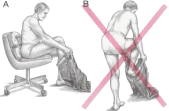 Strain of this back muscle is also seen in motor vehicle accidents when the impact is from the driver’s side and from behind as in a whiplash accident. Sustained or repetitive strain from activities such as gardening, scrubbing the floor or walking on slanted surfaces can also be causative.
Strain of this back muscle is also seen in motor vehicle accidents when the impact is from the driver’s side and from behind as in a whiplash accident. Sustained or repetitive strain from activities such as gardening, scrubbing the floor or walking on slanted surfaces can also be causative.
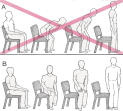 Chronic back strain of the quadratus may also result from a bed that is too soft or sleeping on one side with the hips rotated (a supportive body pillow, leg pillow or knee pillow can correct this), leaning over a desk with poor elbow support, standing and leaning over a low sink or work surface, and carrying a wallet in your back pocket where it raises one side of the pelvis when sitting – remove wallet from back pocket and use the front pocket instead.
Chronic back strain of the quadratus may also result from a bed that is too soft or sleeping on one side with the hips rotated (a supportive body pillow, leg pillow or knee pillow can correct this), leaning over a desk with poor elbow support, standing and leaning over a low sink or work surface, and carrying a wallet in your back pocket where it raises one side of the pelvis when sitting – remove wallet from back pocket and use the front pocket instead.
Other factors may cause chronic irritation and strain of this muscle includes skeletal factors such as a short pelvis on one side, short upper arms, or a short leg on one side, which should be addressed professionally if suspected. If the pain is more when standing and/or walking, suspect a short leg and if more when sitting suspect short arms or short pelvis on one side. A clue to a short leg is standing with one foot forward and the weight on the back foot (short side) or standing with feet wide apart and hips shifted to one side (short side).
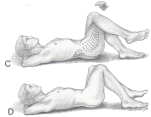 A good stretch for the muscle is illustrated on the right side. Lay on your back with the hips and knees bent. Place hands behind the head to elevate the ribcage. Cross the left leg over the right thigh. Allow the right leg to relax and move towards the left side without forceful pressure from the left leg.
A good stretch for the muscle is illustrated on the right side. Lay on your back with the hips and knees bent. Place hands behind the head to elevate the ribcage. Cross the left leg over the right thigh. Allow the right leg to relax and move towards the left side without forceful pressure from the left leg.
Then inhale deeply as your left leg resists a gentle pull from the right leg back to the right. Then exhale and relax the right leg allowing the left leg to gently pull the right thigh to the left and slightly down. In small increments, repeat the inhale and exhale procedure to stretch further. Remember to go slow and do not exert a lot of force. When done, release the right leg and return to the initial position and relax before getting up. This method uses isometric contraction to enhance the effectiveness of the stretch.
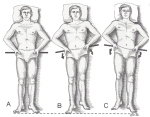 Another stretch for the muscle is the hip-hike exercise to maintain active range of motion throughout the muscle. This is performed alternately by first lowering on hip away from the shoulder while elevating the hip on the other side to that shoulder, and then reversing sides. The tilting motion of the pelvis stretches the quadratus on one side and then the other. Perform slowly while inhaling as you elevate the hip on the injured side and breathe out while lowering it. As you progress, bend your knees and have your feet flat as you perform these for additional stretching.
Another stretch for the muscle is the hip-hike exercise to maintain active range of motion throughout the muscle. This is performed alternately by first lowering on hip away from the shoulder while elevating the hip on the other side to that shoulder, and then reversing sides. The tilting motion of the pelvis stretches the quadratus on one side and then the other. Perform slowly while inhaling as you elevate the hip on the injured side and breathe out while lowering it. As you progress, bend your knees and have your feet flat as you perform these for additional stretching.
Remember to take it slowly with these stretches as overstretching can also cause strain. Perform them slowly and gradually over a period of weeks using correct breathing technique.
A 2011 study in the European Spine Journal showed that impaired back muscle function resulting from muscle fatigue or pain can lead to an inability to adapt postural control strategies.
Another area of back muscle strain actually involves a muscle in the front of the body and if you have no results treating the back muscles, a psoas syndrome should be considered, along with a piriformis muscle syndrome, which can cause sciatic nerve problems and mimic a herniated disc.
We know that it is important to address muscle problems early. Problems with muscles in the back can be an indicator of a more insidious process. A 2018 review BMC Musculoskeletal Disorders found that actual changes in the muscle was associated with disc herniation, radiculopathy like sciatica, and joint degeneration in the lumbar spine. While their meta-analysis was not conclusive for stenosis or narrowing of the spinal canal, we do see muscle changes with severe disc degeneration like Modic I spinal degeneration.
A 2019 study in Science Reports found that individuals with low back pain display a delayed onset of the flexion relaxation phenomenon. This is an indication of muscle stiffness or lack of normal electrical signal muscle function when bending forward. Research was done using high density electromyography. This can be used to document muscle problems as well as have implications for safe lifting.

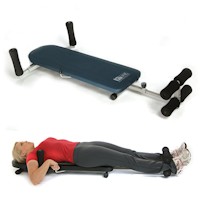 Traction & Inversion
Traction & Inversion Supports & Cushions
Supports & Cushions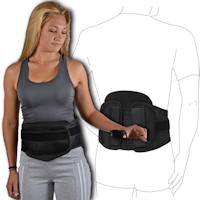 Belts & Corsets
Belts & Corsets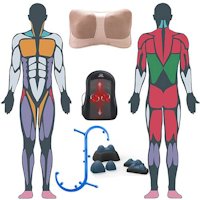 Massage Tools
Massage Tools Relief Supplements
Relief Supplements Topical Relievers
Topical Relievers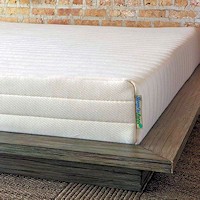 New Mattresses
New Mattresses Heat Therapy
Heat Therapy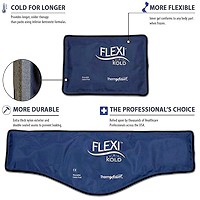 Cold Therapy
Cold Therapy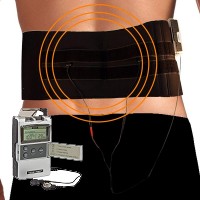 TENS Therapy
TENS Therapy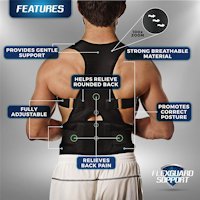 Posture Braces
Posture Braces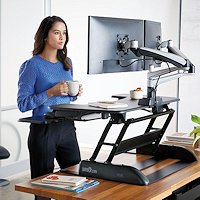 Ergonomic Aids
Ergonomic Aids